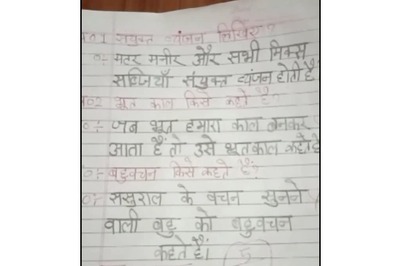
views
It is premature to believe that Delhi, Maharashtra and other states have crossed the peak of Covid-19 third wave, Dr Samiran Panda, additional director general at the Indian Council of Medical Research (ICMR), told News18.com.
According to Panda, who is a trained tropical medicine specialist and a scientist, Covid-19 infections are progressing and declining at a different pace in some states and districts, therefore, it will be “incorrect” to say there will be a collective peak for the country.
“Different states in India are at different stages of Covid-19 infections, epidemiologically. The local data show different trends and we must understand that India — as the overall country – will not reach its peak, rather the different states will reach the peak at different times,” he said.
The head of the epidemiology and infectious diseases division at ICMR, Dr Panda says India should to follow the ‘one-shoe-doesn’t-fit-all’ approach.
“Just replace ‘shoe’ with ‘data’. Every state data is throwing a different trend. There are several pictures, which are emerging in India, state-wise, which show pandemics are in different states,” he pointed out.
He added it will be incorrect to say India is reaching a peak or has crossed the peak as “the country as a whole is not throwing a common trend”.
In states such as Delhi and Mumbai, the graph is coming down.
On January 14, more than 89,000 Covid-19 cases were recorded in Maharashtra, which is the highest so far after the Omicron variant arrived in India. However, the cases are now plateauing with 39,000 daily infections reported on January 18.
Similarly, Delhi touched over 24,000 Covid-19 cases on January 14 but it saw a dip after it recorded 13,785 infections on January 19.
Dr Panda’s says his analysis show that the trend could be a “temporary fluctuation” and a sustained trend for at least three weeks will throw exact conclusions.
“Drawing inference about a trend in rise in infection or fall by analysing the data over just a few days may suffer from fluctuations due to various influences such as weekend dips in the number of tests conducted. A sustained trend observed over a period of at least 3 weeks will help drawing better conclusions,” he explained.
“We still don’t know if the decline in reported number of infections that is being observed in Mumbai is a temporary fluctuation or a permanent trend and we can’t conclude if the peak of the wave has surpassed,” Dr Panda stressed.
He also stressed, “We still don’t know if this is a temporary fluctuation or a permanent trend and we can’t conclude if the wave has surpassed. Next week, we may see things changing again. We must wait for the data for successive three weeks. Starting from today, we can catch a trend after two weeks now to ensure that it’s a sustained trend.”
The difference in state level trends are influenced by various factors such as population density, travelling patterns between districts and states, mixing between different population groups among many other reasons, he explained.
Hospitalisations Mostly Due to Underlying Health Conditions
So far, the data shows only those Covid cases with co-morbidities have been hospitalised, Dr Panda said.
“Hospitalisations are not taking place due to only Omicron-caused Covid-19 disease,” he said while adding that the patients are on oxygen or ventilators due to underlying co-morbidities such as liver cirrhosis, chronic kidney disease or uncontrolled diabetes.”
Hence, associated comorbidities are bringing more people to hospitals and not the new Omicron variant.
Test Performance Should Be Maintained
According to the World Health Organization (WHO), 140 tests should be done per million people for a comprehensive surveillance and testing of population.
Panda insisted that the states should follow the benchmark test performance. Decrease in the number of tests performed by a state will not help characterise the epidemic in the respective state.
All states must follow the new testing strategy guideline and should test as per it.
“It’s necessary for the states to characterise the epidemic well and conduct tests on symptomatic individuals. Also, home testing kits should be used and people should be encouraged to upload the results after such kits are used at home.”
Read all the Latest India News here




















Comments
0 comment